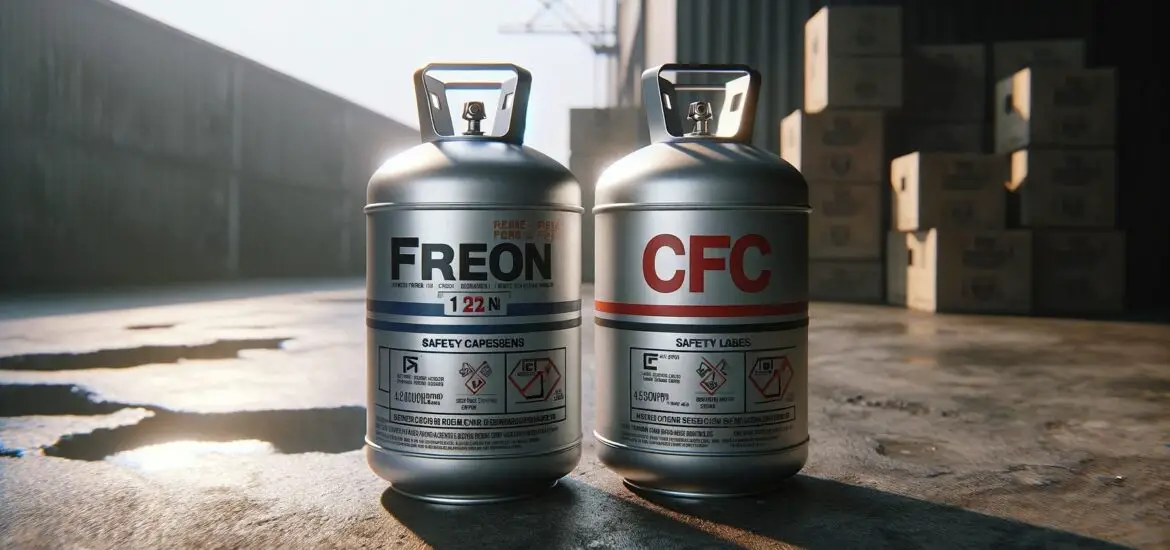The terms “Freon” and “CFC” are often used interchangeably, but they hold different meanings and implications. This article is designed to elucidate the distinct difference between Freon and CFC, ensuring that you walk away with a clear and precise understanding.

Table of Contents
What is Freon?
Freon is the registered trademark of The Chemours Company for a series of halocarbon products. These are primarily used as refrigerants and include various types of chlorofluorocarbons (CFCs), hydrochlorofluorocarbons (HCFCs), and hydrofluorocarbons (HFCs).
Initially, ‘Freon’ referred to a single type of CFC refrigerant used in air conditioning systems. Over time, as environmental concerns necessitated the development of less harmful refrigerants, the term Freon started to encompass a wider range of halocarbon-based refrigerants.
Each type of Freon is identified by a unique number, which corresponds to a specific molecular composition. For example, R-22, R-134a, and R-410A are different types of Freon, each with varying levels of chlorofluorocarbons and other halogens.
It’s important to note that while all Freons are refrigerants, not all refrigerants are Freon – a distinction that’s critical for understanding their use and regulation.
What are CFCs?
Chlorofluorocarbons, or CFCs, are a group of man-made compounds that contain chlorine, fluorine, and carbon. They were developed in the early 20th century and became popular due to their stability and non-toxicity, which made them ideal for many applications, including in refrigeration systems, aerosol propellants, and foam-blowing agents. The most commonly known CFC is R-12, which was used in car air conditioning systems.
The stable nature of CFCs means they do not break down in the lower atmosphere and can remain intact for many years, eventually reaching the stratosphere. It was this characteristic that led to their widespread use, as it was initially believed to mean they were safe.
However, this stability turned out to be detrimental to the ozone layer, leading to significant international environmental concerns and policy changes.
Difference Between Freon and CFC
Now, let’s carefully examine the difference between Freon and CFC. To ensure we cover this, we’ll look at three major areas:
Understanding the Chemical Differences
The chemical differences between Freon and CFCs are nuanced, as Freon is a subset of CFCs. Freon originally consisted of CFCs but has expanded to include HCFCs and HFCs. CFC molecules are composed of chlorine, fluorine, and carbon atoms.
In contrast, HCFCs include hydrogen, chlorine, fluorine, and carbon atoms, and HFCs include hydrogen, fluorine, and carbon, omitting the chlorine.
The presence of hydrogen in HCFCs and HFCs makes these molecules less stable in the lower atmosphere, causing them to decompose before reaching the stratosphere, which minimizes their ozone-depleting potential compared to CFCs.
However, while HCFCs and HFCs are less harmful to the ozone layer, they still possess global warming potential (GWP), representing their ability to trap heat in the atmosphere and contribute to climate change.
Environmental Impact
The environmental impact of CFCs, including those Freons that are CFCs, has been profound. In the 1970s, scientists discovered that CFCs released into the atmosphere gradually make their way to the stratosphere, where they are broken down by ultraviolet radiation.
This process releases chlorine atoms, which then react with ozone (O3) molecules, breaking them down into oxygen (O2). A single chlorine atom can destroy over 100,000 ozone molecules, according to the U.S. Environmental Protection Agency.
This depletion of the ozone layer is problematic because it reduces our planet’s natural protection against the sun’s harmful ultraviolet radiation. Increased UV exposure can lead to higher rates of skin cancer and cataracts in humans and has harmful effects on animals and plants.
Freons that are HCFCs and HFCs were developed to mitigate this issue, but they still contribute to another significant environmental concern: global warming.
Current Usage and Regulations
The usage of CFCs has been heavily regulated following the Montreal Protocol, an international treaty adopted in 1987 to phase out substances that deplete the ozone layer. The production and consumption of CFCs have been phased out since 2010 for all but a few critical uses.
HCFCs, which are less harmful to the ozone layer, are also being phased out under the same protocol, with a complete ban expected by 2030 for most countries.
As for HFCs, they do not deplete the ozone layer but do contribute to global warming. Consequently, the Kigali Amendment to the Montreal Protocol, which came into effect in 2019, is phasing down the production and consumption of HFCs.
In response, the industry is turning to newer alternatives, such as hydrofluoroolefins (HFOs) and natural refrigerants, which have much lower global warming potentials and no ozone-depleting characteristics.